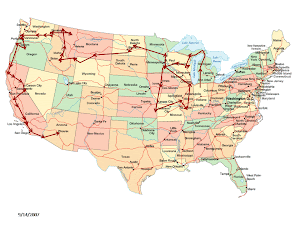
 Mt St Helens gave warning as she was bulging on the side before the eruption. A helicopter does a controlled burn after the timber has been cut so seeding can begin.
Mt St Helens gave warning as she was bulging on the side before the eruption. A helicopter does a controlled burn after the timber has been cut so seeding can begin.
 The valley above has 150 feet of deposit from the eruption. The gray deposit on the tree is ash baked on from the volcano. Lumberjacks had to knock it off before cutting as it would dull their saws. There were also trees that had their bark blown off from the hurricane force of the volcano.
The valley above has 150 feet of deposit from the eruption. The gray deposit on the tree is ash baked on from the volcano. Lumberjacks had to knock it off before cutting as it would dull their saws. There were also trees that had their bark blown off from the hurricane force of the volcano. These are some people we met from Germany. They drove this German made Heavy Duty RV around Europe and to Africa and then had it shipped here and are touring the US for a year.
These are some people we met from Germany. They drove this German made Heavy Duty RV around Europe and to Africa and then had it shipped here and are touring the US for a year.Yesterday we toured the Mt St Helens area. While the clouds shrouded the mountain and we couldn’t see it, we visited the educational centers and learned a lot about the mountain and its eruption starting on May 18, 1980.
· The blast power was equal to thousands of atomic bombs.
· In less than ten minutes the eruption levels 230 square miles of forest.
· The mountain lost 1300 feet of height and .67 cubic miles of total volume.
· The eruption began with a massive landslide (debris avalanche) that buried 14 miles of river valley to an average depth of 150 feet.
· Because the blast was so powerful, it pushed the sound waves up and no sound of the erupting volcano was heard for 60 miles.
· The landslide released trapped magma and gas, producing a sideways explosion (lateral blast) of hot rock and ash killing trees up to 17 miles north of the volcano. A vertical ash eruption rose to a height of 15 miles above the crater and continued for 9 hours.
· Something I learned is that the heat of the eruption melts the snow cap and frozen glacier ice and caused flooding. There was a picture of mailboxes 35 miles away that were virtually covered by the flow. Add to the water the rocks and hot magma and it is quite a horrible thing.
· One of the hardest hit industries was logging. Weyerhaeuser lost approximately 60,000 acres of trees. Logging camps, buildings and equipment were also lost or damaged. Many of the trees near the mountain were a total loss but much of the forest blown flat in the lateral blast could be saved. By November of 1982, the Weyerhaeuser Lumber Company had recovered enough blown down trees to build 85,000 three bedroom homes. At times, they were hauling 600 semi loads of logs per day away from the area. After the recovery came the daunting task of planting, by hand, more than 18.4 million trees over 45,500 acres. Test plots showed that normal survival and growth could be expected as long as the ash was scraped away so the seedlings roots could be placed directly in the mineral rich soil below.
· Weyerhaeuser logged 21,000 acres of damages trees in 2 years with over 1000 men.
· October 2004 Mt St Helens erupts after 18 years of quiet. Lava extrudes from the crater floor at the rate of one dump truck load per second and builds a new lava dome. May 2007 Lava extrusion decreases (a small pickup load every 2 seconds. No explosive eruptions in a year.
Here is a link to frequent questions about Mt St Helens.
http://volcano.und.edu/vwdocs/frequent_questions/group6_new.html
If you want to see a live web cam of Mt St Helens, here is the link. Remember we are three hours different from Indiana. http://www.fs.fed.us/gpnf/volcanocams/msh/
Eagle Facts
· In less than ten minutes the eruption levels 230 square miles of forest.
· The mountain lost 1300 feet of height and .67 cubic miles of total volume.
· The eruption began with a massive landslide (debris avalanche) that buried 14 miles of river valley to an average depth of 150 feet.
· Because the blast was so powerful, it pushed the sound waves up and no sound of the erupting volcano was heard for 60 miles.
· The landslide released trapped magma and gas, producing a sideways explosion (lateral blast) of hot rock and ash killing trees up to 17 miles north of the volcano. A vertical ash eruption rose to a height of 15 miles above the crater and continued for 9 hours.
· Something I learned is that the heat of the eruption melts the snow cap and frozen glacier ice and caused flooding. There was a picture of mailboxes 35 miles away that were virtually covered by the flow. Add to the water the rocks and hot magma and it is quite a horrible thing.
· One of the hardest hit industries was logging. Weyerhaeuser lost approximately 60,000 acres of trees. Logging camps, buildings and equipment were also lost or damaged. Many of the trees near the mountain were a total loss but much of the forest blown flat in the lateral blast could be saved. By November of 1982, the Weyerhaeuser Lumber Company had recovered enough blown down trees to build 85,000 three bedroom homes. At times, they were hauling 600 semi loads of logs per day away from the area. After the recovery came the daunting task of planting, by hand, more than 18.4 million trees over 45,500 acres. Test plots showed that normal survival and growth could be expected as long as the ash was scraped away so the seedlings roots could be placed directly in the mineral rich soil below.
· Weyerhaeuser logged 21,000 acres of damages trees in 2 years with over 1000 men.
· October 2004 Mt St Helens erupts after 18 years of quiet. Lava extrudes from the crater floor at the rate of one dump truck load per second and builds a new lava dome. May 2007 Lava extrusion decreases (a small pickup load every 2 seconds. No explosive eruptions in a year.
Here is a link to frequent questions about Mt St Helens.
http://volcano.und.edu/vwdocs/frequent_questions/group6_new.html
If you want to see a live web cam of Mt St Helens, here is the link. Remember we are three hours different from Indiana. http://www.fs.fed.us/gpnf/volcanocams/msh/
Eagle Facts
Bald eagles mate for life and return each spring to rebuild the nest. They add to it each year and nest in large trees have been known to ne 9 feet wide by 20 feet deep and weigh as much as 2 tons.
Wood Facts
Every day, every person in the world, uses wood. Wood is one of the world’s most important resources. It shows up in homes and other buildings, paper products, furnishings and tools. In addition to these, more than 5,000 other products come from or contain ingredients from trees. And still, 50% of the wood used around the world is burned for cooking and heating.
Wood Facts
Every day, every person in the world, uses wood. Wood is one of the world’s most important resources. It shows up in homes and other buildings, paper products, furnishings and tools. In addition to these, more than 5,000 other products come from or contain ingredients from trees. And still, 50% of the wood used around the world is burned for cooking and heating.


No comments:
Post a Comment